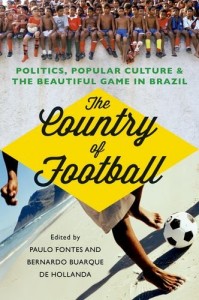Book Review: The Country of Football – Politics, Popular Culture & the Beautiful Game in Brazil, edited by Paulo Fontes and Bernardo Buarque de Hollanda
 When many people think of Brazil, they conjure up images of a joyful mix of football, samba, carnival and beaches and therefore maybe puzzled by the demonstrations that have occurred in the preparation and build-up to the World Cup. The reality is that Brazil is a complicated country which as the introduction to The Country of Football says, “…stems from its explosive growth, and the struggles to adapt economics, social and political institutions to the new realities of the country…”.
When many people think of Brazil, they conjure up images of a joyful mix of football, samba, carnival and beaches and therefore maybe puzzled by the demonstrations that have occurred in the preparation and build-up to the World Cup. The reality is that Brazil is a complicated country which as the introduction to The Country of Football says, “…stems from its explosive growth, and the struggles to adapt economics, social and political institutions to the new realities of the country…”.
This book explores how the country has developed and provides an insight into why there has been unrest from some of the Brazilian population and an understanding of the importance of football to the country. These nine essays look at the links between football and the country in a social and anthropological context.
Make no mistake this is no ‘run of the mill’ football book. You’ll not find any, ‘the boy done good’, football clichés. The writing is unashamedly academic with contributions from historians, professors and those with PhD’s; so be prepared for a style and language that is more thesis than terrace banter.
The nine chapters follow pretty much a chronological flow and include the formation of football in Brazil in the late 1890s by Anglo-Brazilian Charles Miller, the professionalism of football in Brazil (1930 – 1950), Amateur Football Clubs in Sao Paulo (1940s – 1960s), ‘Dictatorship, Re-Democratisation and Brazilian Football in the 1970s and 1980’s’ and bringing the story up to date with a chapter on the impact of the 2014 World Cup on Brazil’s football stadiums and culture.
The three stand-out chapters for me are, ‘The People’s Joy Vanishes: Meditations on the Death of Garrincha’, ‘Public Power, the Nation and Stadium Policy in Brazil: The Construction and Reconstruction of the Maracana Stadium for the World Cups of 1950 and 2014’ and ‘A World Cup for Whom? The Impact of the 2014 World Cup on Brazilian Football Stadiums and Cultures’. The reasons? Well, Garrincha is acknowledged as one of Brazil’s greatest players and this chapter highlights the difficulties he endured in his career, the obscurity of his death, but which ended with a national outpouring at his funeral. In terms of my other favoured essays, they both have a connection to the impending World Cup, which makes them more accessible than some of the earlier historical pieces.
Nevertheless, it is a book that gave me a greater understanding of how football in Brazil has developed, its links to politics and the class structure, where the sport lies in the countries sporting psyche and goes some ways to explaining the stance of the working-classes in the recent demonstrations; I will certainly will be revisiting all the chapters of the book in the future.
Finally, the writers maybe academic, but they understand football too, a point perfectly illustrated in the final essay which looks at the impact of the 2014 World Cup:
“Financed with public money and controlled by public interests, World Cup stadiums will be worlds of consumption isolated from their urban and cultural contexts.
The accepted business wisdom of football suggests that this is the only way forward for Brazilian football. The private sector has undertaken no risk in developing the World Cup and the public sector has overachieved in its desire to put forth a ‘positive image’ of Brazil to the world. The wanton destruction of historic stadiums has been accompanied by a lack of transparency and accountability on the part of tournament organisers. Football’s institutions have not recognised the very real threats to traditional football culture in Brazil. To the contrary these very institutions have worked closely with private interests to change the form and function of Brazilian stadiums as well as the ‘kind’ of people that go there. These processes have the potential to permanently alter an essential element of Brazilian cultural identity. Ironically, it is the cultural weight of football as created and sustained by ‘o povo’ (the people), that has made possible its saleability in the global marketplace’.
Read The Country of Football and see the 2014 World Cup in a different light.